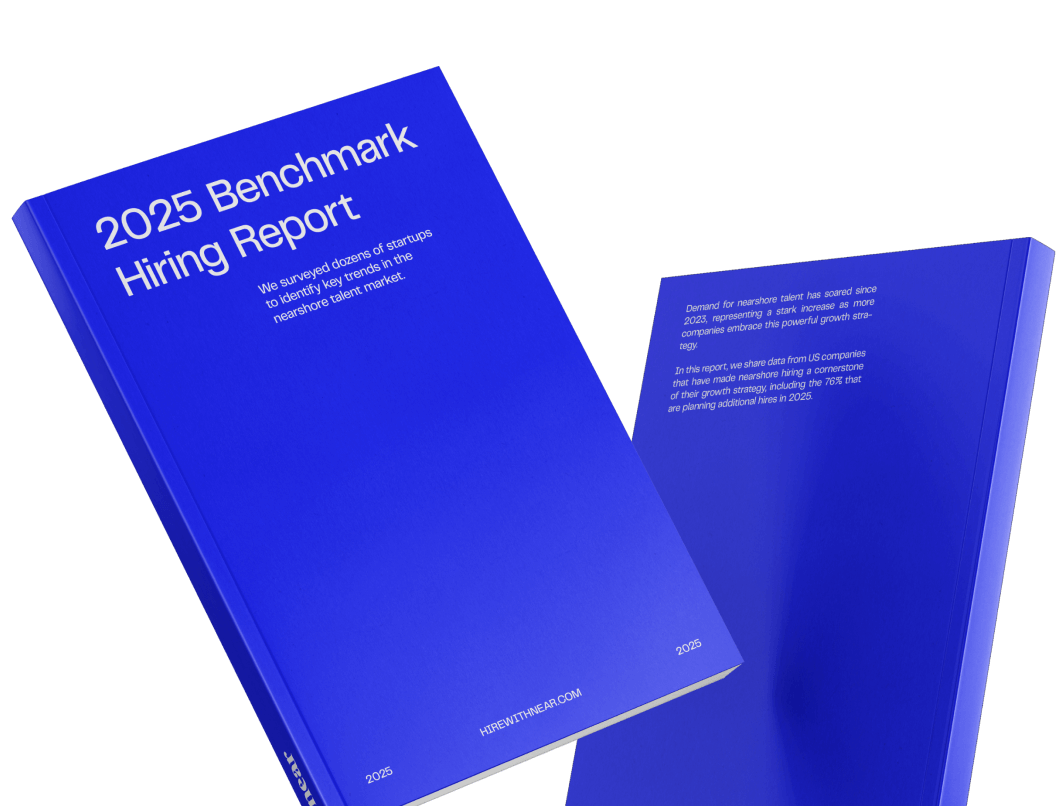For many companies, especially start-ups or small businesses, finding, hiring, and training in-house talent for web development may not be feasible or affordable. There may be a shortage of developers in your area, a lack of organizational resources to bring them on board, or not enough consistent work to require a full-time employee.
That’s why outsourcing has become a popular alternative, offering access to talented developers who can work efficiently and, often, at a lower cost than hiring an in-house team.
Handing off these critical tasks can be anxiety-inducing, however, with concerns surrounding quality and consistency.
But as this article explores, outsourcing web development does not have to mean sacrificing quality. Through careful planning, you can ensure your project is successful.

What Is Outsourcing Web Development?
Outsourcing website development is when you hire a third-party agency or individual to develop and manage your company’s website or online app instead of having employees do it.
External contractors or companies specializing in web development offer services ranging from simple coding tasks to full-stack website design and ongoing maintenance.
Outsourcing doesn’t necessarily have to come from outside the US. However, with the country’s ongoing developer shortage, many are turning to regions like Latin America to find developers with the skills and expertise they need, often at a more budget-friendly cost.
What Are the Pros of Outsourcing Web Development?
The business case for web development outsourcing is an easy one to make. It comes with several significant benefits.
Cost savings
Through outsourcing, you can significantly reduce the labor costs and overall development costs of your website. Freelancers or outsourcing companies usually offer competitive rates compared to hiring and retaining an in-house team of developers.
For example, you can easily find and hire a mid-level developer in Mexico, a country that has a booming software industry, for an annual salary ranging from $50,000 to $70,000. That’s well below the US median of $91,000.
These savings can be reinvested in other business growth strategies like marketing, training, product development, and expansion.
Time efficiency
Outsourcing can be a time-efficient solution for web development projects, thanks to highly skilled, experienced professionals ready to work on your project immediately.
They have the infrastructure to manage the development process, from various programming languages to project management tools. This means you can hit the ground running. In contrast, an in-house team might need set-up, integration, and learning time, delaying the project.
Access to top talent
With outsourcing, you’re not limited to the pool of developers in your local area or country. You can tap into global talent, giving you access to individuals and teams with a broad range of skills and experiences that may not be available nearby.
For example, thanks to government support and abundant high-quality software development university programs, Latin America has become a tech start-up hotspot.
With expertise in the latest technologies and industry trends, you can outsource to Latin American web developers to ensure your website is of the highest quality.
Flexibility and scalability
One of the biggest benefits of outsourcing is the ability to scale up or down as needed.
Scope creep is a common problem in software and web development, meaning your required resources can change dramatically. Outsourcing allows you to adjust the size of your remote team accordingly without the need to hire or lay off permanent employees.
If you need more developers for certain tasks or periods, you can easily arrange it with your partner agency. Similarly, if your workload decreases, you can downsize the dedicated team without the headaches of HR processes.
Focus on core competencies
Outsourcing web development allows your in-house team to concentrate on core business activities. This frees up time and resources you can reinvest into strategic business areas such as:
- Customer service
- Research and development
- Sales
- Marketing
Handing off web development to trusted experts ensures it’s taken care of while you focus on your business goals.

What Are the Cons of Outsourcing Web Development?
Still, there are some downsides to outsourcing web development.
Communication challenges
Communication difficulties can be an issue when working with overseas development teams due to time differences and language barriers. Misunderstandings can lead to mistakes, delays, or errors in the final product. Getting timely responses or arranging meetings can also be challenging.
Nearshoring, hiring from nearby countries, can help mitigate some of these concerns. For example, developers in Mexico will be working during US business hours and have enough cultural similarities to integrate into US business environments quickly.
Quality control issues
Monitoring quality in an outsourced project can be challenging. The finished product might not meet your expectations if the vendor doesn’t share your standards. Many factors, such as lack of direct supervision or inadequate technical skills, can affect the quality of your project.
However, you can mitigate these issues by clearly defining and communicating your expectations, creating a detailed project agreement, and maintaining regular communication.
We’ll discuss quality control more closely further down with six specific tips to follow.
Dependency on external vendors
Outsourcing creates a dependency on the external team for updating, maintaining, and troubleshooting your website or application. If, for any reason, you need to terminate your contract with that vendor, you might find it challenging to transfer their knowledge and skills to a new team or an in-house department.
This dependency can be managed by including knowledge transfer clauses in the initial contract, having regular updates and comprehensive documentation of the development process, and encouraging your in-house developers to learn from the outsourced team.
Lack of control
Outsourcing inevitably means giving up some level of control. When you outsource a project, you don’t have direct control over the team’s skills, work habits, or quality of work.
This can lead to discrepancies in expectations and delivery. A good vendor will be transparent, provide regular updates, involve you in the major decision-making processes, and give you a sense of control over the project.
Intellectual property concerns
Sharing business-critical information with an external party always comes with risk. Intellectual property (IP) theft or misuse is always possible when giving an outsider access to your data.
However, you can ensure you are protected by having strong confidentiality and nondisclosure agreements (NDAs) in all outsourcing contracts.
Enforcing these can be trickier when dealing with other countries with different IP laws, so it’s always wise to work with a reputable partner and seek legal advice before starting an outsourcing relationship.

How To Maintain Quality While Outsourcing Web Development
Quality control is the most difficult part of outsourcing. It can be hard to manage the quality of work being done remotely, particularly in different time zones or languages.
But with thorough planning, you can outsource without sacrificing quality. Here are six tips on ensuring quality control while outsourcing web development:
1. Establish clear requirements
Start by identifying the goals of your website or application. Consider what functionalities and elements you want it to include and what kind of user experience you aim to provide.
Once these goals are established, translate them into detailed specifications that your outsourced team will follow.
These should clearly outline the requirements and expectations for the project. Include as much detail as possible regarding the design, technology stack, functionality, compatibility requirements, and performance metrics.
Remember to have open discussions with the developers about these requirements. The developers can provide valuable input based on their experiences with similar projects, which can help shape your project’s direction and improve outcomes.
2. Choose a reliable outsourcing partner
Even the most meticulously planned project can fail without the right people executing it. So, carefully selecting your outsourcing partner is a crucial factor.
Start by looking for companies with a demonstrable track record in web development. They should have solid skills and extensive experience relevant to your project. Look at their portfolio and case studies and seek references or testimonials from previous clients to gauge their capability and reliability.
Ask questions like:
- Do they consistently deliver high-quality work?
- How do they handle project complications?
- Are they recognized industry leaders?
- Do they have experience in your platform or preferred language? (e.g. Do you need developers with experience in Bubble, Ruby on Rails, C#, Python, etc.?
All these factors will give you an idea of their work ethic, reliability, and ability to fulfill project requirements.
3. Define quality standards
Defining the quality standards your project must adhere to from the beginning is essential. This could include the quality of:
- Code
- Design
- User interface
- Performance
- Security
Specific standards may depend on your industry regulations, the website’s purpose, and target audience needs.
Make sure to communicate these expectations to your outsourcing partner clearly. You can create a standards document that explicitly outlines all these criteria or include it in the project’s scope documents.
4. Implement quality assurance processes
Quality assurance (QA) processes are a way of preventing errors in the final product. They provide a framework for systematically checking a project’s processes and results against the pre-defined quality standards.
Essential QA processes should include testing and code reviews:
Testing
Testing web development projects is done in several ways.
- Functional testing: Ensuring each function works as intended
- User acceptance testing: Checking that it meets user requirements and expectations
- Performance testing: Confirming it can handle the anticipated loads
- Security testing: Verifying its ability to protect data and withstand threats
Conducting these tests at different stages of the development process can help catch problems early.
Code reviews
Peer or code reviews by senior developers can help identify potential issues and ensure that the code adheres to the set standards and best practices.
Implementing robust QA processes as part of the development workflow increases the likelihood of you receiving a high-quality website. It catches any issues early, reducing the time and cost spent fixing bugs after launch.
5. Regular communication
Outsourcing isn’t a set-it-and-forget-it process. There needs to be regular, consistent communication to make sure that any misunderstanding is quickly addressed.
Constant communication keeps the project on schedule and ensures that your outsourcing partner doesn’t try to guess your intentions or requirements. It means that questions can be asked, instructions modified, or additional context provided.
Remember that this communication needs to be supportive but also firm and direct so there is no ambiguity about what you want.
6. Protect intellectual property
As mentioned above, one of the primary concerns about outsourcing web development is the risk of intellectual property misuse or theft. IP protection—legal agreements and safeguards—should be in place before the work commences.
The outsourcing partner’s familiarity with and willingness to sign these agreements is a good indicator of quality. Conversely, their unfamiliarity with standard IP protection protocols can serve as an early warning sign that they won’t be able to live up to a certain standard.

How To Choose the Right Outsourcing Partner
So, how do you find the right outsourcing partner? (A partner that will put quality control as high up their priority list as you do.) Follow these five steps:
1. Evaluate your needs
Before you do anything else, determine the skills and expertise you need from an outsourcing partner. Remember, there are different ways to find help.
You can outsource work directly to a freelancer (or independent contractor), leveraging their specific experience and in-depth knowledge of a certain coding language. This can be a great option for a smaller project that can be tackled by one person.
It also means that you might not only find a good match for a single project but also a long-term fit that could work with and support your in-house team.
An agency, on the other hand, has access to a broader range of skills, resources, and scalability. They may be a better fit if you need a dedicated, experienced team, if your project is complex, or if you are planning an ongoing relationship with consistent work.
2. Verify provider references
Check any references, testimonials, and reviews you can find, or request them directly from the provider. These will give you insights into their track record, reliability, and client satisfaction.
3. Find a provider who understands your market
Remember to look for an outsourcing partner with experience and market knowledge. They should understand what kind of customer you’re targeting, the compliance challenges of your sector, and what their work will be compared to in terms of your competition.
You’ll experience better project outcomes and more effective collaboration with someone who understands precisely what you need.
4. Assess communication and collaboration
It doesn’t bode well for a working arrangement if you’re struggling to communicate in the screening process.
Don’t hesitate to set high standards from the first interaction, as effective and timely communication is crucial for successful project execution and achieving the quality you expect.
5. Consider security measures
Any outsourcing web development partner you work with should have a robust understanding of best security practices, including any industry-specific legislation.
For instance, if you are working with sensitive healthcare data, your partner needs experience with HIPAA regulations, or you will face risk and potential legal complications.
Final Thoughts
Outsourcing web development can be an effective way to save money while accessing the expertise of professionals who may not be in your area.
Of course, like everything, outsourcing comes with some challenges. But nothing that can’t be overcome with some planning and appropriate measures. And, as we’ve shown, outsourcing doesn’t have to mean you sacrifice quality.
By partnering with us at Near, we can quickly get you set up with a reliable, high-quality developer with the skills you need. We thoroughly screen our candidates for English ability and programming skills and have a replacement policy if there is any issue. By hiring from Latin America, you can save 30–70% compared to working with a US-based developer.
Fill out this form today to get a list of pre-vetted web developers you can interview for free. We usually have our clients set up with the talent they need in under 21 days.













.png)






%20(1).png)
%20(1).png)
